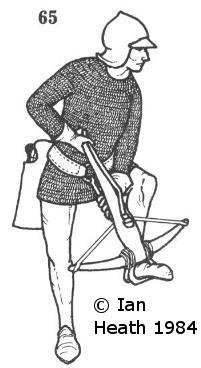
Join Amazon Prime - Watch Thousands of Movies & TV Shows Anytime - Start Free Trial Now
VENETIAN CROSSBOWMAN c.1410
An extract from Armies of the Middle Ages, Volume 2by Ian Heath



65. VENETIAN CROSSBOWMAN c.1410
A law of the Venetian senate of 1303 says ‘the masters of the galleys must hire bowmen [selected] according to the rules made by the councils, 30 for each galley, and they must row the galley ad terzarolos’; later it emphasises that among the crew of every galley there were to be 30 such bowmen ‘who nevertheless shall be obliged to row’. Even at that early date, however, they might occasionally be exempted from rowing by special licence, and by the end of the 14th century crossbowmen were actually forbidden to take part in any shipboard activity that was unconnected with crossbows. They continued to be called ‘bowmen’ even after the introduction of handguns, by which time most galleys only carried 20 bowmen (though the Senate ordered 10-20 extra to be taken aboard on dangerous voyages). After 1461 some were officially required to be gunners, 6 per galley being specified in a law of that year, increased to 8 in 1486. Round ships carried considerably less bowmen, perhaps 4-8 on a ship of average tonnage.
Michael Mallett, in Mercenaries and their Masters, observed that ‘Venetians all learnt to fire a crossbow as part of their civic obligations’, so Muntaner’s description of Catalan crossbowmen could probably be applied with equal accuracy to those of Venice. He wrote that they were all ‘people who can renovate a crossbow, and every one of them knows how to put it together, and how to make the light darts and the bolts, and how to twist and tie the string, and he understands all that pertains to a crossbow.’
The figure depicted here wears a long-sleeved mail corselet (giacho), a celata helmet, and leather gauntlets. Some other Venetian crossbowmen in the fresco are more heavily equipped in brigandines and arm-harness, but they are all invariably shown with their legs unarmoured.
[Based on a Naval Battle by Spinello Aretino, fresco in the Palazzo Pubblico in Siena, 1406-7]